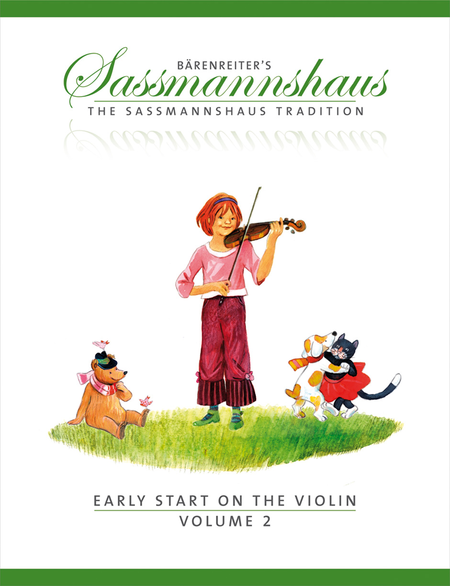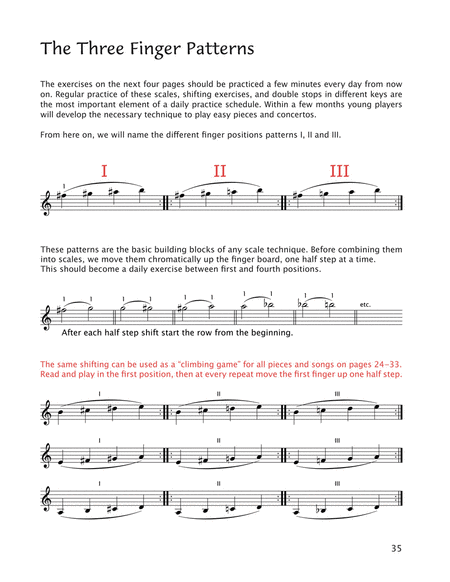Early Start on the Violin, Volume 2
A violin method for children
-
Ships in 24 hours
Details
Description
SKU: BA.BA09677
A violin method for children. Composed by Egon Saßmannshaus and Kurt Sassmannshaus. Stapled. Barenreiter's Sassmannshaus. Instructional. Method book. With Text language: English. 64 pages. Baerenreiter Verlag #BA09677. Published by Baerenreiter Verlag (BA.BA09677).ISBN 9790006536412. 30 x 23 cm inches. Language: English. Illustrations: Charlotte Panowsky.
Original German title: Fruher Anfang auf der Geige - Band 2; Eine Violinschule fur Kinder. The second volume already presents classical violin duets. The child's knowledge and technique is expanded by dotted rhythms, sixteenths notes, and first double stops. And here is the most revolutionary aspect of the method: different finger more...patterns can be connected and combined to create any major and minor scale without the use of open strings. This creates the ability to practice scales in any position, often within the first year of playing! With this skill, songs learned in first position are easily transposed to other keys and higher position. Coupled with beginning shifting exercises this sets a foundation for an early virtuoso technique not available in any other method.
About Baerenreiter's Sassmannshaus
Children playfully learn reliable technique at the earliest age. For more than three decades the Sassmannshaus Tradition has been the household name for excellence in beginner methods in German-speaking countries. More than half a million students have successfully learned to play using this publication.
This tried and tested German method is now available in English! The best-selling method that gave generations of European musicians their foundation is now available in English, with content and songs newly adapted for today's English speaking children.
What makes this method so special?
- The child-friendly and age-appropriate text underlying the music enables children to perceive melodies as a whole and to understand their singable qualities.
- Songs and scales in different positions are easily explained and mastered within the first year. This is an important advantage over methods that confine children to the first position for many years.
- Note reading is emphasized from the first lesson - children are brought up to become proficient sight-readers and play in chamber music ensembles as early as possible.
- In contrast to other beginner methods, The Sassmannshaus Tradition progresses swiftly by introducing advanced techniques in rudimentary form, such as shifting and varied bow strokes.
- Ensemble playing is encouraged from the very beginning.
- The method is suitable for single instruction as well as for group and class lessons.
- The large print notes and text as well as many colorful illustrations are particularly child-friendly and very attractive to pre-school children and school children alike.
- The substantial volumes contain comprehensive material and carefully calibrated learning curves. They keep children curious and interested for many months and years.
Song List (94)
- Preface
- The Third Finger is the Tonic
- Up the Ladder
- Bought Me a Cat
- All the Little Hamsters
- Triads in C major, G major and D major
- Pit A Pat Rain
- Pat-A-Cake
- Tower Song
- Songs with the New Finger Pattern
- Bye, Baby Bunting
- Song of the Nightingale
- That's One HOT Potato
- Exercise
- Spielstuck
- Children's Song
- Ancient Dance
- Are You Sleeping? (Frere Jacques)
- The Dotted Quarter Notet
- Canon
- Five German Folk Tunes: Waltz I
- Five German Folk Tunes: Waltz II
- Five German Folk Tunes: Traditional
- Five German Folk Tunes: Birds Announcing The Spring
- The Second Finger Changes Between High and Low Positions
- Summer Song
- Spring Has Arrived
- Returning Home
- A Fiddler in the Circus
- The States Song
- Hunter's Minuet
- Folk Dance
- Gallop
- Happy Birthday To You
- Sur Le Pont D'Avignon
- Cotillon
- Dance (Gavotte)
- Minuet
- Gavotte
- Rigaudon
- The First Finger is the Lowest Note of the Chord
- Bought Me a Dog
- Folk Song
- Triads in E major, A major and B major
- Ode to Joy
- Exercises with the New Finger Pattern
- Old MacDonald
- Lightly Row
- Go Tell Aunt Rhody
- Winter Song
- Rocky Mountain High
- Good Night Noisy Cricket
- Fast Eighth Notes
- The Hippo Song
- Down at the Station
- Changing Between High and Low Finger Positions
- Bear Dance
- The Three Finger Patterns
- Playing in Different Positions with the Three Patterns
- Double Stops
- The Second Finger is the Tonic
- Folk Tune
- Triads in F major, B-flat major and C major
- Little Peter Rabbit
- German Folk Song
- Horn Call with Echo
- Cuckoo
- Children's Dance
- Allegretto
- Allons, bergers
- Sixteenth Notes
- Tenderly
- Lively
- Good Night Noisy Cricket!
- Allegro
- The First Finger Changes Between High and Low Positions
- Sarabande
- Molto Allegro
- From A Contredanse
- Two Pieces From An Historical Collection
- C major Notes in First Position
- Exercises and Pieces in C major
- Notes on the D and G strings, from Louis Spohr's violin method
- Notes on the A and E strings, from Louis Spohr's violin method
- A Little Exercise
- [Untitled] from Hubert Ries' violin method
- Two Scale Studies, from Hubert Ries' violin method
- Dance
- Allemande
- Andantino, from Beriot's violin method
- Trumpet Piece
- Allegretto, from Louis Spohr's violin method
- [Untitled]
- Major and Minor Scales and Arpeggios Across Four Strings


 Share
Share